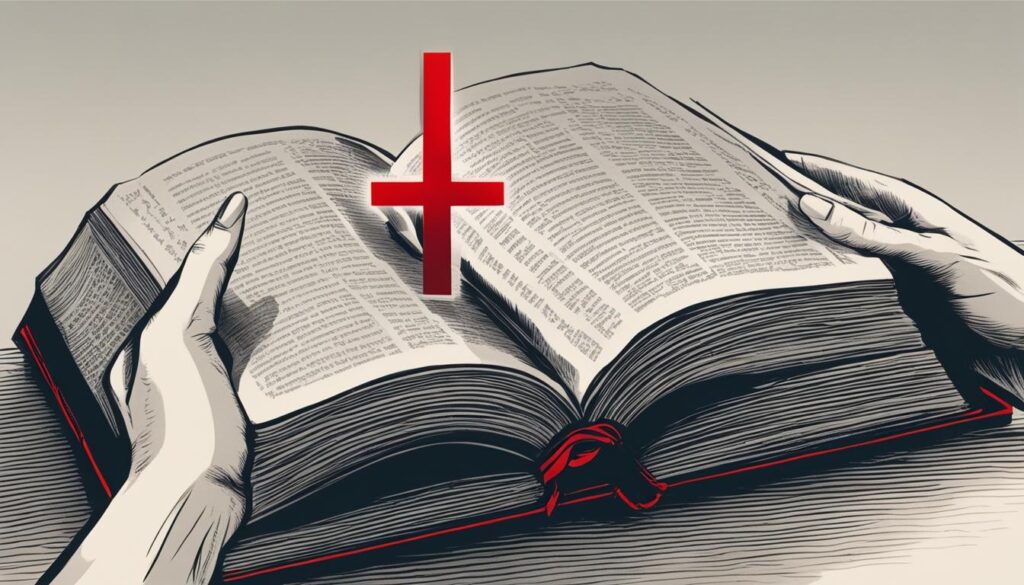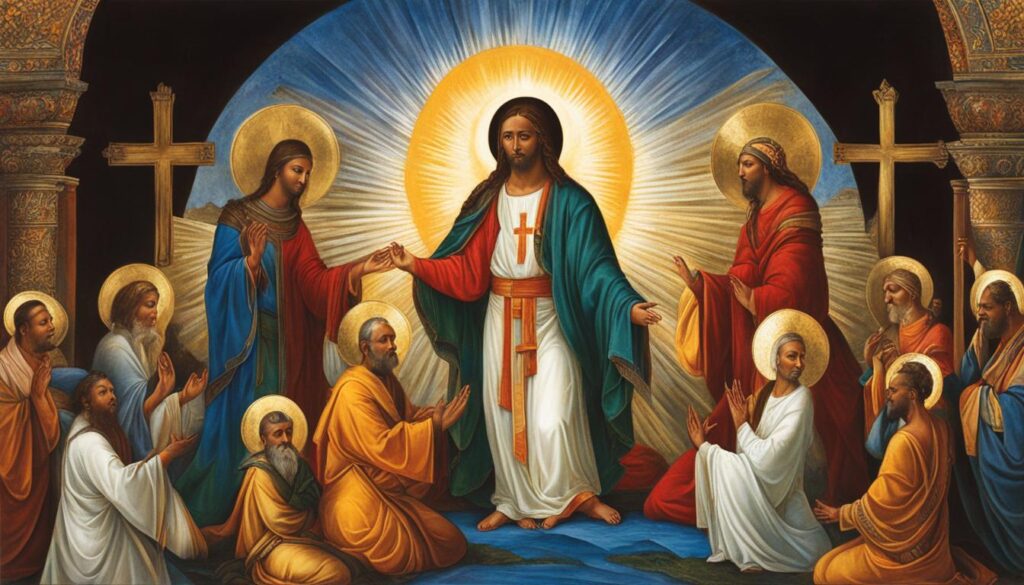When it comes to religious practices, each denomination has its own unique customs and beliefs. One practice that has sparked curiosity and debate among Christians is the sign of the cross. This centuries-old gesture holds deep religious significance for many, but can Protestants partake in this tradition?
Pastor Doug Wilson, in a recent podcast, addressed this question by stating that while it may be lawful for Protestants to do the sign of the cross, it may not be considered appropriate in their religious practices. To understand the reasoning behind this perspective, let’s delve into the historical origins and diverse perspectives on the sign of the cross within Protestantism.
Key Takeaways:
- The sign of the cross is a centuries-old gesture with religious significance.
- Pastor Doug Wilson suggests that while Protestants can technically do the sign of the cross, it may not align with their religious practices.
- Understanding the historical origins and different perspectives within Protestantism is crucial in comprehending this topic.
- The practice of the sign of the cross varies among Protestant denominations and individuals.
- Personal beliefs, theological interpretations, and individual preferences influence whether or not Protestants engage in this practice.
Origins of the Sign of the Cross
The sign of the cross has a rich and intriguing history within Protestantism. While its exact origins are unknown, it is believed to have started as a practice during baptism and gradually spread into everyday life. Early Christians would trace the sign of the cross on their foreheads as a way to signify their Christian identity and devotion to Christ.
The gesture of the sign of the cross evolved over time, with different variations emerging in different cultural contexts within Protestantism. Some cultural variations include using two fingers instead of three, making a vertical line before the horizontal, or even incorporating a bow or genuflection alongside the sign of the cross. These cultural variations reflect the diverse ways in which Protestant believers have embraced and adapted the practice to their own traditions.
Throughout history, the sign of the cross has been a visible symbol of faith and an embodied expression of belief in the Trinity and the Good News of Christ’s death and resurrection. While its specific origins may be shrouded in mystery, the sign of the cross continues to hold significance for many Protestants as a tangible reminder of their identity as followers of Christ.
Sign of the Cross in Different Protestant Denominations:
- Lutheranism: Martin Luther encouraged the sign of the cross as an outward expression of faith and love for Jesus Christ. While not universally practiced among Lutherans today, it still holds a significant place in their liturgical traditions.
- Methodism: Some Methodist traditions incorporate the sign of the cross on certain occasions, such as during baptisms or the Lord’s Supper. However, it is not a common practice in everyday worship.
- Other Protestant Denominations: The sign of the cross is generally not practiced in most Protestant denominations due to a lack of biblical basis or concerns about its association with Catholicism.
Protestant Perspectives on the Sign of the Cross
While most Protestant denominations do not make the sign of the cross, there are some variations in beliefs and practices among different Protestant communities. One notable denomination that has a history of the practice is Lutheranism, with Martin Luther himself encouraging the use of the sign of the cross as an outward expression of faith and love for Jesus Christ. The sign of the cross is seen as a way to visually and bodily proclaim one’s belief in the Trinity and the Good News of Christ’s death and resurrection.
On the other hand, many other Protestants do not make the sign of the cross, citing various reasons. One common concern is the lack of biblical basis for the practice. Some Protestant denominations place strong emphasis on the authority of Scripture and believe that practices should be rooted in clear biblical teachings. Additionally, the sign of the cross is often associated with Catholicism, and some Protestants may feel uncomfortable adopting a practice that they perceive as primarily Catholic.
Another reason why many Protestants do not make the sign of the cross is related to the interpretation of the second commandment. Some interpret the commandment to prohibit the making of any physical representation or gesture associated with God or religious devotion. Concerns about idolatry and the potential violation of this commandment contribute to the hesitation among many Protestants to engage in the sign of the cross.
Biblical Basis and Interpretation
Protestant beliefs on the sign of the cross vary when it comes to the biblical basis for this practice. While some denominations, such as the Wisconsin Evangelical Lutheran Synod, allow their members the freedom to make the sign of the cross if they desire, others view it as having a weak scriptural foundation.
Protestants, Catholics, and Eastern Orthodox all point to different verses to support their perspective on the sign of the cross. However, it’s important to note that none of these verses explicitly mention the specific gesture of tracing a cross over oneself. Different Christian traditions have diverse interpretations and applications of these verses, leading to varying beliefs about the significance and appropriateness of the sign of the cross.
Protestants who do not practice the sign of the cross often cite the lack of a clear biblical mandate as the primary reason. They emphasize the importance of adhering strictly to what is explicitly outlined in the Bible, rather than incorporating practices that are not explicitly commanded or demonstrated by Jesus or the apostles.
Overall, the biblical basis for making the sign of the cross remains a topic of theological discussion and interpretation among Protestants. Each individual and denomination must determine their beliefs and practices based on their understanding of scripture and their theological convictions.
Reformation and the Sign of the Cross

During the Protestant Reformation, the sign of the cross became a point of contention among reformers who associated it with Catholicism and viewed it as a form of idolatry. Many Protestants began to reject the practice, considering it unnecessary or even superstitious. This led to a decline in the usage of the sign of the cross among Protestant denominations.
However, it is important to note that Protestant views on the sign of the cross are not unanimous. While some Protestants continue to view the sign of the cross negatively, others argue that it can be a meaningful and embodied expression of their faith. These individuals believe that making the sign of the cross can serve as a physical reminder of their belief in the Trinity and the redemptive work of Jesus Christ.
As with many aspects of religious practice, beliefs regarding the sign of the cross can vary greatly among individuals and denominations within Protestantism. Some may see it as an important part of their worship, while others may choose not to engage in this practice. Ultimately, the decision to incorporate the sign of the cross into one’s faith life is a personal one, based on individual interpretation and theological beliefs.
Protestant Beliefs on the Sign of the Cross:
- Some Protestants view the sign of the cross as unnecessary or superstitious due to its association with Catholicism.
- Others believe that making the sign of the cross can be a meaningful expression of their faith in the Trinity and the redemptive work of Jesus Christ.
- Beliefs regarding the sign of the cross can vary among individuals and denominations within Protestantism.
- The decision to incorporate the sign of the cross into one’s faith life is a personal one, based on individual interpretation and theological beliefs.
While the sign of the cross may not be widely practiced among Protestants today, it is important to approach these differences in belief with respect and understanding. The sign of the cross, like many religious practices, holds different significance for different individuals and denominations within the Protestant tradition. It is ultimately up to each person to discern their own beliefs and practices in light of their faith.
Embodied Spiritual Practices

Embodied spiritual practices are gaining popularity as individuals seek a deeper connection between body, mind, and spirit in their spiritual journey. These practices provide a holistic approach to worship, engaging not only the intellect but also the physical self. By incorporating physical movements, gestures, or rituals, individuals can enhance their faith experience and cultivate a greater sense of presence and mindfulness.
Blending body, mind, and spirit in spiritual practice can take various forms. For example, practices like yoga combine physical postures, breathwork, and meditation to promote physical well-being, mental clarity, and spiritual growth. This integration allows individuals to engage their entire being in the act of worship, bringing a sense of unity and harmony.
Other embodied spiritual practices may include walking meditations, labyrinth walks, or engaging in mindful eating. These practices encourage individuals to be fully present in the moment, heightening awareness of their connection to the divine. By consciously incorporating the body into the spiritual journey, individuals can deepen their understanding and experience of their faith.
Benefits of Embodied Spiritual Practices:
- Enhanced mindfulness and present-moment awareness
- Deepened connection to the divine
- Increased physical and mental well-being
- Improved focus and concentration
- Stress reduction and relaxation
- Greater sense of unity with others and the world
Personal Rituals and Faith Life

Rituals play a significant role in the faith life of many individuals, regardless of their specific religious beliefs. These rituals serve as a way to connect with the divine and express devotion. They can provide a sense of comfort, spiritual discipline, and a tangible expression of faith. Rituals can be deeply personal and meaningful, allowing individuals to enter into a sacred space and experience a sense of transcendence.
In the context of faith, rituals offer a way to engage our senses and bring intentionality to our spiritual practices. They create a rhythm and structure that helps us connect with the divine on a deeper level. Whether it’s lighting a candle, reciting a prayer, or performing a physical gesture, rituals allow us to pause, reflect, and acknowledge the sacredness of the moment.
Importantly, rituals provide a tangible connection to our beliefs and serve as a reminder of our faith traditions. They can be a source of comfort during times of uncertainty or difficulty, offering a sense of continuity and stability. Rituals also foster a sense of community as they are often practiced collectively, creating a shared experience and strengthening the bonds of faith.
Examples of Rituals in Faith Life:
- Prayer: Whether through structured liturgical prayers or spontaneous conversations with the divine, prayer is a fundamental ritual in many faith traditions.
- Sacraments: In Christian traditions, sacraments such as baptism and communion are sacred rituals that symbolize and commemorate important aspects of the faith.
- Meditation: Practiced in various forms across different religions, meditation allows individuals to still their minds, cultivate inner peace, and connect with the divine.
- Chanting and Singing: The rhythmic repetition of sacred words or melodic hymns can create a meditative atmosphere and facilitate a deeper spiritual experience.
- Seasonal Celebrations: Rituals associated with religious holidays and festivals mark the passage of time and provide an opportunity for communal worship and reflection.
Ultimately, rituals in faith life are deeply personal and hold different meanings for each individual. They provide a sense of identity, belonging, and connection to something greater than ourselves. Whether through established traditions or personal practices, rituals can enrich our spiritual journey and nourish our souls.
Conclusion
In conclusion, the practice of making the sign of the cross varies among different Christian traditions and individuals. Although most Protestants do not engage in this practice, some denominations, like Lutheranism, have a historical connection to it. Ultimately, the decision to do the sign of the cross is based on personal interpretation, theological beliefs, and individual preference.
Embodied spiritual practices, like the sign of the cross, can enhance one’s faith experience by incorporating the body, mind, and spirit. However, the significance of rituals ultimately depends on personal conviction and understanding. While rituals, such as the sign of the cross, can be deeply meaningful and serve as a way to connect with the divine, they are not universally practiced or considered necessary within Protestantism.
As individuals navigate their faith journeys, they have the freedom to choose whether to incorporate rituals like the sign of the cross into their personal spiritual practices. Whether one finds value in the sign of the cross or not, it is important to respect the diversity of perspectives within the Protestant community and recognize that the essence of faith lies in the heart rather than in specific gestures or rituals.
FAQ
Can Protestants do the sign of the cross?
Yes, Protestants have the freedom to do the sign of the cross if they desire, although it is not a common practice among most Protestant denominations.
What is the origin of the sign of the cross?
The origin of the sign of the cross is not known for certain, but it is believed to have started as a practice during baptism and then spread into everyday life as a way to signify one’s Christian identity.
What do Protestants believe about the sign of the cross?
Protestants have different beliefs about the sign of the cross. While some view it as a meaningful expression of faith, others may see it negatively due to its association with Catholicism or lack of biblical basis.
Is there a biblical basis for making the sign of the cross?
The biblical basis for making the sign of the cross is a topic of interpretation and varies among different Christian traditions. While some verses are pointed to as support, they do not explicitly mention the specific gesture of tracing a cross over oneself.
What was the Protestant Reformation’s impact on the sign of the cross?
During the Protestant Reformation, the sign of the cross was challenged by reformers who associated it with Catholicism and considered it a form of idolatry. This led to a decline in the practice among Protestant denominations.
What are embodied spiritual practices?
Embodied spiritual practices involve engaging the body, mind, and spirit in one’s spiritual practice. These practices can enhance one’s faith experience and provide a more holistic approach to worship.
How important are personal rituals in faith life?
Personal rituals play an important role in the faith life of many individuals, regardless of their specific religious beliefs. These rituals can be deeply personal and meaningful, serving as a way to connect with the divine and express devotion.

